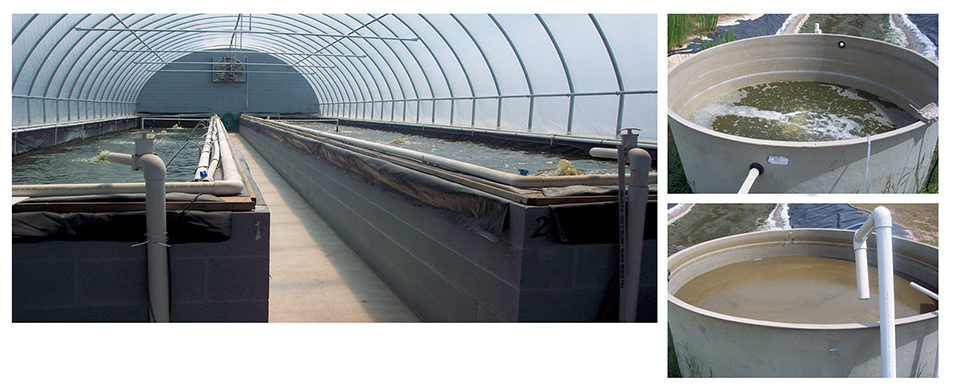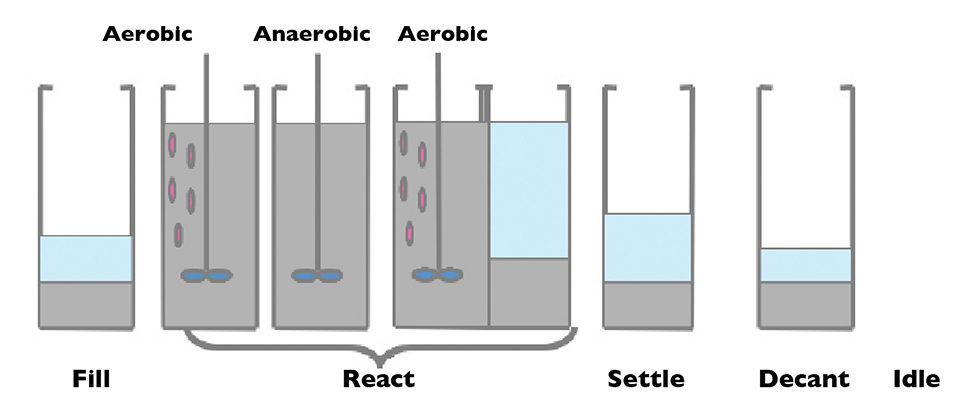Simple systems incorporate aerobic and anaerobic processes in a single reactor

Wastewater from shrimp aquaculture operations contains high concentration of ammonia, nitrate, nitrite and organic carbon due to the high-protein diets fed to shrimp. High concentrations of nitrate and nitrite are toxic to shrimp and cause high mortality, so effective treatment of wastewater is imperative.
The biological treatment of organic waste using activated sludge is a proven technology found in municipal sewage treatment facilities. Conventional anaerobic treatment processes have been used to reduce the organic carbon concentrations of liquids, but these processes have not been successful in reducing both carbon and nitrogen at a reasonable cost.
Animal culture systems with little or no water exchange rely on technological filtration systems to biologically and mechanically treat wastewater to reduce the carbon and nitrogen levels. A major disadvantage of limited-exchange systems is the accumulation of sludge, which must be concentrated, collected and physically removed from the aquaculture facility.
Sequencing batch reactors
An innovative design known as a sequencing batch reactor (SBR) can minimize capital costs by incorporating both aerobic and anaerobic processes in a single reactor.
An SBR is a variation of the activated sludge biological treatment process that accomplishes equalization, aeration and clarification in a timed sequence in a single reactor basin. A conventional continuous-flow process requires multiple structures and extensive pumping and piping systems. The sequencing series for treatment consists of defined stages – fill, react, settle, decant and idle – that are carried out in a single reactor as shown in Fig. 1.

SBR study
The author recently conducted a study with funding support from the United States Department of Agriculture, National Institute of Food and Agriculture and U.S. Marine Shrimp Farming Program to assess the use of sequencing batch reactors in treating shrimp aquaculture wastewater.
Shrimp wastewater was collected from an intensive recirculating shrimp facility at the Gulf Coast Research Laboratory in Ocean Springs, Mississippi, USA. The initial characteristics of the water are shown in Table 1. The wastewater contained high concentrations of carbon, ammonia, nitrate and nitrite.
Two 500-L pilot-scales SBRs were operated aerobically at the laboratory for the first three days and then operated anoxically until the end of the experiment on day 9. In the aerobic stage of the SBR process for nitrogen removal, the carbon oxidation and nitrification were combined into a single process to achieve nitrification and carbon removal. Denitrification was accomplished in the anoxic stage.
Boopathy, Characteristics of shrimp, Table 1
| Parameter | Concentration |
|---|
Parameter | Concentration |
|---|---|
| Total organic carbon (mg/L) | 1,593.0 ± 36.0 |
| Total solids (g/L) | 33.1 ± 3.9 |
| Ammonia (mg/L) | 83.7 ± 6.1 |
| Nitrate (mg/L) | 31.3 ± 1.4 |
| Nitrite (mg/L) | 250.0 ± 22.7 |
| Salinity (ppt) | 28.6 ± 0.4 |
| pH | 8.1 ± 0.1 |
Results
The reactor performance data are presented in Table 2. There was almost 100 percent removal of ammonia, nitrate, nitrite and organic carbon from the shrimp wastewater within seven days.
The wastewater contained heterogenic populations of bacteria to carry out nitrification and denitrification reactions as well as carbon metabolism. The nitrifying organisms dominated the system during the aerobic operation of the reactor. This was evidenced by the data on the removal of ammonia (Table 2).
Boopathy, Mean performance of pilot-scale SBRs, Table 2
| Time (days) | Condition | Ammonia-Nitrogen (mg/L) | Nitrite-Nitrogen (mg/L) | Nitrate-Nitrogen (mg/L) | Carbon (mg/L) |
|---|
Time (days) | Condition | Ammonia-Nitrogen (mg/L) | Nitrite-Nitrogen (mg/L) | Nitrate-Nitrogen (mg/L) | Carbon (mg/L) |
|---|---|---|---|---|---|
| 0 | 93.7 ± 54.9 | 266.0 ± 74.0 | 21.3 ± 20.5 | 1,593.0 ± 811.0 | |
| 1 | Aerobic | 55.7 ± 42.2 | 661.0 ± 298.0 | 27.8 ± 14.8 | 1,177.0 ± 669.0 |
| 2 | Aerobic | 19.4 ± 25.9 | 94.0 ± 70.0 | 19.2 ± 8.9 | 190.0 ± 7.8.0 |
| 3 | Aerobic | 9.8 ± 4.7 | 58.1 ± 19.3 | 65.0 | – |
| 4 | Anaerobic | 3.6 ± 8.6 | 46.3 ± 12.5 | 20.5 ± 4.1 | – |
| 5 | Anaerobic | – | 20.0 | 16.8 ± 20.1 | – |
| 6 | Anaerobic | – | – | – | – |
| 7 | Anaerobic | – | 18.0 | 0 | – |
While aquaculture wastewater is often addressed through a combination of activated sludge processing, foam fractionation, filtration and sludge management, these systems can be costly and expensive to operate. SBR systems are simple in design and use multiple steps in the same reactor to take the place of multiple reactors in a conventional system. At the end of the SBR operation, the sludge can be dewatered, and water can be recycled back into shrimp production.
(Editor’s Note: This article was originally published in the March/April 2012 print edition of the Global Aquaculture Advocate.)
Author
-
Raj Boopathy, Ph.D.
Department of Biological Sciences
Nicholls State University
Thibodaux, Louisiana 70310 USA
Tagged With
Related Posts

Health & Welfare
Barcoding, nucleic acid sequencing are powerful resources for aquaculture
DNA barcoding and nucleic acid sequencing technologies are important tools to build and maintain an identification library of aquacultured and other aquatic species that is accessible online for the scientific, commercial and regulatory communities.

Intelligence
Aquaculture UK: Stepping up to the plate
There’s considerable opportunity to grow the UK aquaculture industry. At the Aquaculture UK exhibition and conference in Aviemore, Scotland shows the way.

Innovation & Investment
Artemia, the ‘magic powder’ fueling a multi-billion-dollar industry
Artemia, microscopic brine shrimp used as feed in hatcheries, are the unsung heroes of aquaculture. Experts say artemia is still inspiring innovation more than 50 years after initial commercialization. These creatures are much more than Sea-Monkeys.

Innovation & Investment
A review of unit processes in RAS systems
Since un-ionized ammonia-nitrogen and nitrite-nitrogen are toxic to most finfish, controlling their concentrations in culture tanks is a primary objective in the design of recirculating aquaculture systems.


